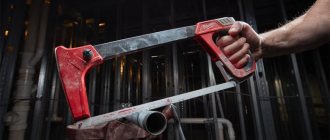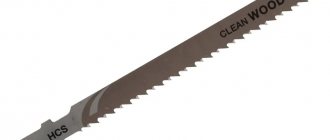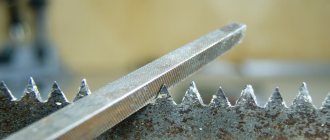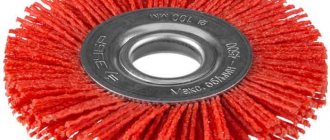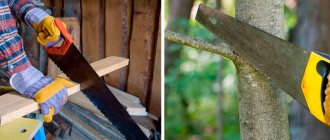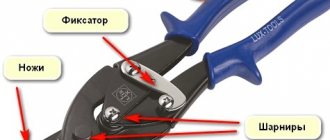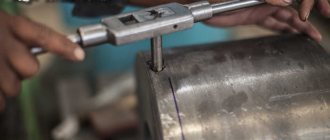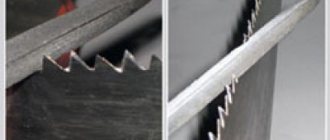Classic hacksaws for metal will never go out of use. Yes, although this tool has low performance, there are many situations when It is permissible, or rational, to cut only with a hand saw.
When working with a hacksaw, a master cannot do without a blade . It is the hacksaw blade that acts on the surface being processed and makes the cut. Linens are consumables. Competent specialists try to pay special attention to the choice of hacksaw blades . This review will talk about the types of metal blades.
Blades for metal differ from blades for cutting wood mostly only in the size of the teeth. If teeth of medium and high height (from 2-3 to 7-10 mm) are well suited for cutting wood, then for metal processing you need the smallest teeth, a height of about 1-1.5 (mm).
The hacksaw blade is a removable part of the metal saw; the saw edge is located on it. The surface of the saw edge has a serrated profile . The height of the teeth usually ranges from 1-1.5 (mm) . If we talk about blades for machine sawing equipment for metal, then the height of the toothed part can reach 2-2.5 (mm).
Knowing how to choose a blade for a hacksaw, you can save a lot, because an incorrectly selected toothing very quickly becomes dull or even bursts.
Types of hacksaw blades
According to GOST standards for hacksaw blades, there are two types of blades: for cutting by hand and by machine.
Manual cutting blades have three main parameters:
- The distances in single models between fasteners are 250+/-2 millimeters. The canvas is 265 millimeters in length.
- The gap in single models between the fasteners is about 300 millimeters. The canvas has a length of 315 millimeters.
- Double. The distance between the fasteners is 300 millimeters. The canvas is 315 millimeters in length.
The thickness of the hacksaw blade (in a single version) does not exceed 0.63 millimeters, in a double version – 0.80 millimeters. The height of models with a single row of teeth is 12.5 millimeters, in models with a double row – 20 millimeters.
GOST requirements regulate tooth pitch, distance, quantity.
What are they made from?
A modern hacksaw blade for metal is made from the following types of steel:
- Carbon - they have low strength values, so they can be used for cutting non-ferrous and soft metals. A headset of this class is marked HCS, and the degree of strength does not exceed 44-46 HRC. The price of such paintings from well-known manufacturers reaches 140 rubles
- High-speed - they have high resistance to abrasion and tooth wear, but their disadvantage is fragility. High-speed saws are marked with the designation HSS and have a hardness level of up to 73-78 HRC. There are blades made of high-speed steel with diamond coating, which have a hardness level of up to 82-84 HRC. The cost of such devices reaches 160-180 rubles per piece
- Bimetallic - received this name due to the use of two types of steel. Their release made a splash on the market, quickly displacing their analogues. Bimetallic blades are based on materials such as carbon steel, onto which a strip of high-speed steel is welded. These types of devices are designated by the letters BIM, and their cost is 250-300 rubles. In terms of strength, they are the same as high-speed cutting, only due to the use of carbon steel as the main material, they have high strength and resistance to deformation
- Alloyed tool steels are modernized models of carbon analogues, which are made by alloying carbon with chromium, tungsten, vanadium, silicon, etc. Alloying makes it possible to achieve high strength indicators, and the degree of hardness is slightly lower than that of high-speed steel, and is 67-67 HRC. The price of such devices does not exceed 200-250 rubles
This is interesting!
The presented cost of the set in question for a hand saw for metal is approximate, since it depends on many indicators, such as thickness, length, number of teeth, as well as currency exchange rate fluctuations.
The hardness of a hand saw set characterizes the sensitivity of the equipment to bending stress, therefore, depending on the cutting devices used, it is necessary to take into account the force applied to the hacksaw during operation. Typically, the force should not exceed 60 kg, which is typical for equipment with a tooth pitch of less than 1.4 mm. If the tooth pitch is more than 1.4 mm, then the load should not be more than 10 kg.
Universal hacksaws
Hacksaw blades for metal are narrow saws that are equipped with thin teeth. They are easily recognized by their frame, similar to the letters C and P, onto which the hacksaw blade is tensioned. Outdated models are equipped with handles (placed parallel to the blade). The modernized models already have a “pistol” handle.
Hacksaws for working with wood are considered the most common type of tool. Used for sawing plywood and various wooden building materials. They are equipped with slightly beveled working surfaces, where sawing teeth are attached to the sides.
A hacksaw for concrete materials can be visually confused with a joiner's saw. The difference is the large teeth. There are models with soldered carbide material. This allows you to saw not only foam blocks, but also sand-concrete materials.
Methods for installing the canvas
There are two types of fastening systems on hand hacksaws:
- threaded clamp;
- lever mechanism.
In the first case, the canvas is stretched between the mounting holes and secured with a wing nut. In the second, the actions are performed similarly, only the file is put on and removed using a special lever, usually located at the edge farthest from the handle.
The blade is installed in such a way that the teeth tilt in the direction opposite to the handle. When using a hacksaw, the metal layer will be cut while moving away from you. The reverse direction - "toward" - is idle, in which the workpiece is not cut. Therefore, efforts during the reverse movement are in vain. In addition, it is so easy to dull the teeth of the blade.
For electric hacksaws, the working part is attached differently. For example, below is the process of replacing the blade on a Makita JR 3070 CT reciprocating saw. To do this you need:
- turn the holder head counterclockwise at a slight angle so that the internal slot allows you to remove the product;
- remove the canvas;
- Place the end of the new file into the slot of the holder until you hear a characteristic click.
By the way, the blades are also divided by the type of shank (the section that connects to the holder). There are shanks with one stop, two-jaw, universal 1/4, clamping 1/2 and special for Makita saws, which have two holes at the end.
The principle of attaching hacksaw blades to reciprocating saws is the same for all devices; The manufacturers thought through the design, made inserting the cutting element convenient and made the user’s work easier.
How to identify a quality tool
In order to understand how high-quality the device is, you need to take into account the following parameters:
Working blade length. It will depend on the size of the workpiece. The average length of the working part is from 300 to 700 millimeters.
Pitch of teeth. This parameter determines how hard or thick the material that requires cutting should be. For example, a step of 3.5 millimeters is used to cut soft wood materials. Steps of 5 millimeters are used for working with harder wood species.
When choosing a hacksaw blade, be sure to consider the quality of the coating. If the coating is of poor quality, the enamel may crack during operation.
Teeth setting
Removal of chips from the cutting zone is carried out due to a certain layout of the cutting edge. As previously noted, according to this criterion, several options are distinguished:
- Wiring for each.
- Setting through one or two teeth.
At the same time, attention is paid to the direction of the teeth. Taking this parameter into account, the plate is installed.
Today, many tool manufacturers specialize in the production of hacksaw blades. At the same time, domestic products are much cheaper, foreign ones are more expensive, but at the same time have higher performance characteristics. For long-term operation, several products are required, as they can wear out at a high rate.
If you find an error, please select a piece of text and press Ctrl+Enter.
What are the differences between the tools?
All hacksaw blades can be divided into two types - for household and industrial work (in the photo of the hacksaw blade the difference is visible to the naked eye). The advantages of industrial devices include structures with a rigid base, as well as the fact that they can be operated at an angle of 55 and 90 degrees.
Household tools are used for lightweight work; they may be a little “stormy” during cutting. The home version is much cheaper than a professional tool.
Recommendations and tips for using hacksaws with metal blades
Experts recommend using the tool correctly in order not only to achieve positive results, but also to prevent injury. The recommendations are as follows:
- Inspect the canvas before carrying out work. There should be no cracks or signs of corrosion on it
- Make sure the saw is flexible enough. If the device is slightly bent, it should return to its original position. If distortions appear after bending, the tool is not recommended for use.
- The sawing speed depends on the number of teeth. The more there are, the smaller they are, so the sawing process occurs slowly, but efficiently. The fewer the teeth, the larger their size, which means the sawing process is faster.
- For materials, you need to choose the appropriate blades, which will increase productivity as well as service life
- The markings of each canvas are indicated on their surface
- The choice of equipment must be approached correctly, and not from the cost side. Cheap black files cannot compare with expensive analogues
Having analyzed the blades for hacksaws for metal, you can easily choose the appropriate option for cutting metal workpieces. If the tool is not used, it must also be stored correctly. If the blade is broken, but the teeth have not been worn out, then do not rush to dispose of it, since you can easily make a knife from it with your own hands.
